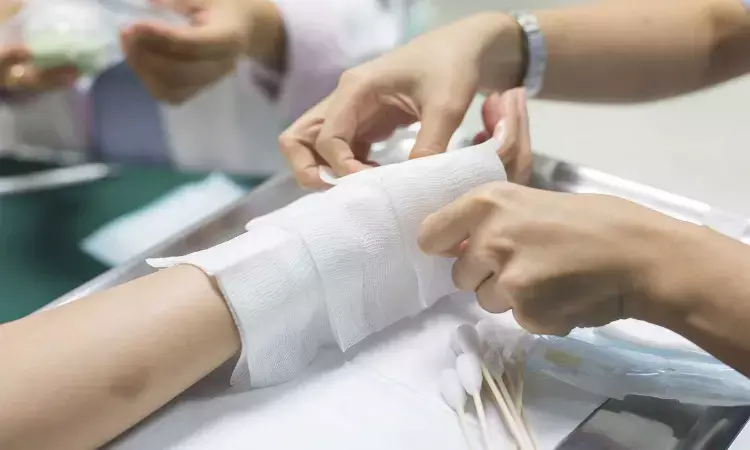- Home
- Medical news & Guidelines
- Anesthesiology
- Cardiology and CTVS
- Critical Care
- Dentistry
- Dermatology
- Diabetes and Endocrinology
- ENT
- Gastroenterology
- Medicine
- Nephrology
- Neurology
- Obstretics-Gynaecology
- Oncology
- Ophthalmology
- Orthopaedics
- Pediatrics-Neonatology
- Psychiatry
- Pulmonology
- Radiology
- Surgery
- Urology
- Laboratory Medicine
- Diet
- Nursing
- Paramedical
- Physiotherapy
- Health news
- Fact Check
- Bone Health Fact Check
- Brain Health Fact Check
- Cancer Related Fact Check
- Child Care Fact Check
- Dental and oral health fact check
- Diabetes and metabolic health fact check
- Diet and Nutrition Fact Check
- Eye and ENT Care Fact Check
- Fitness fact check
- Gut health fact check
- Heart health fact check
- Kidney health fact check
- Medical education fact check
- Men's health fact check
- Respiratory fact check
- Skin and hair care fact check
- Vaccine and Immunization fact check
- Women's health fact check
- AYUSH
- State News
- Andaman and Nicobar Islands
- Andhra Pradesh
- Arunachal Pradesh
- Assam
- Bihar
- Chandigarh
- Chattisgarh
- Dadra and Nagar Haveli
- Daman and Diu
- Delhi
- Goa
- Gujarat
- Haryana
- Himachal Pradesh
- Jammu & Kashmir
- Jharkhand
- Karnataka
- Kerala
- Ladakh
- Lakshadweep
- Madhya Pradesh
- Maharashtra
- Manipur
- Meghalaya
- Mizoram
- Nagaland
- Odisha
- Puducherry
- Punjab
- Rajasthan
- Sikkim
- Tamil Nadu
- Telangana
- Tripura
- Uttar Pradesh
- Uttrakhand
- West Bengal
- Medical Education
- Industry
Procalcitonin kinetics useful for sepsis diagnosis in major burn patients: Study

China: A recent study in the journal Burns showed that procalcitonin (PCT) kinetics early after burn could be a prognostic factor for mortality and sepsis among major burn patients. This implies that serum PCT levels in major burn patients could be a diagnostic biomarker for sepsis.
Severe bacterial infection remains the leading cause of death despite the great advances in the field of burn care. Sepsis is the most common severe complication occurring in major burn patients and is a cause for very high mortality. Early diagnosis followed by adequate antimicrobial therapy is critical for improving the diagnosis of sepsis patients.
Against the above background, Jianglin Tan, State Key Laboratory of Trauma, Burn and Combined Injury, Chongqing, PR China, and colleagues aimed to investigate the clinical significance of PCT kinetics early afterburn and the perioperative period in a retrospective study. Also, they assessed the diagnostic performance for sepsis in major burn patients.
The study included major burn patients (≥40% total body surface area who were admitted to Southwest Hospital, Chongqing, China from 2014 to 2019. A total of 321 patients were included. PCT kinetics was analyzed during the 1st-week afterburn, the perioperative period, and at the onset of clinical suspected sepsis.
The study revealed the following findings:
- Serum PCT concentration rose immediately after burn injury.
- Factors associated with increased PCT level in the 1st week after burn include greater burn area (>70% TBSA) and lower age (≤14 years).
- Correlations between PCT kinetics after burn and the risk of early development of sepsis and mortality were observed.
- At the onset of sepsis, serum PCT increased significantly compared to its basal level in the 48 h before diagnosis.
- The area under the receiver operating characteristics curve of PCT concentration and its kinetic changes was 0.788 and 0.826, respectively.
- PCT kinetics showed better accuracy than PCT concentration in discrimination of Gram-positive sepsis.
- The optimal diagnostic thresholds for PCT concentration and its kinetics were 1.41 ng/mL, and a 1.34-fold elevation compared to the baseline level.
"PCT kinetics in the early stage after burn was a prognostic factor for sepsis and mortality among major burn patients," wrote the authors. "Serum PCT levels could be a diagnostic biomarker for sepsis patients with major burns."
Reference:
Jianglin Tan, Ning Li, Yali Gong, Lili Yuan, Junyi Zhou, Gaoxing Luo, Procalcitonin kinetics early after severe burn injury and its value in diagnosis of sepsis, Burns, Volume 47, Issue 8, 2021, Pages 1802-1809, ISSN 0305-4179, https://doi.org/10.1016/j.burns.2021.02.024.
Dr Kamal Kant Kohli-MBBS, DTCD- a chest specialist with more than 30 years of practice and a flair for writing clinical articles, Dr Kamal Kant Kohli joined Medical Dialogues as a Chief Editor of Medical News. Besides writing articles, as an editor, he proofreads and verifies all the medical content published on Medical Dialogues including those coming from journals, studies,medical conferences,guidelines etc. Email: drkohli@medicaldialogues.in. Contact no. 011-43720751


